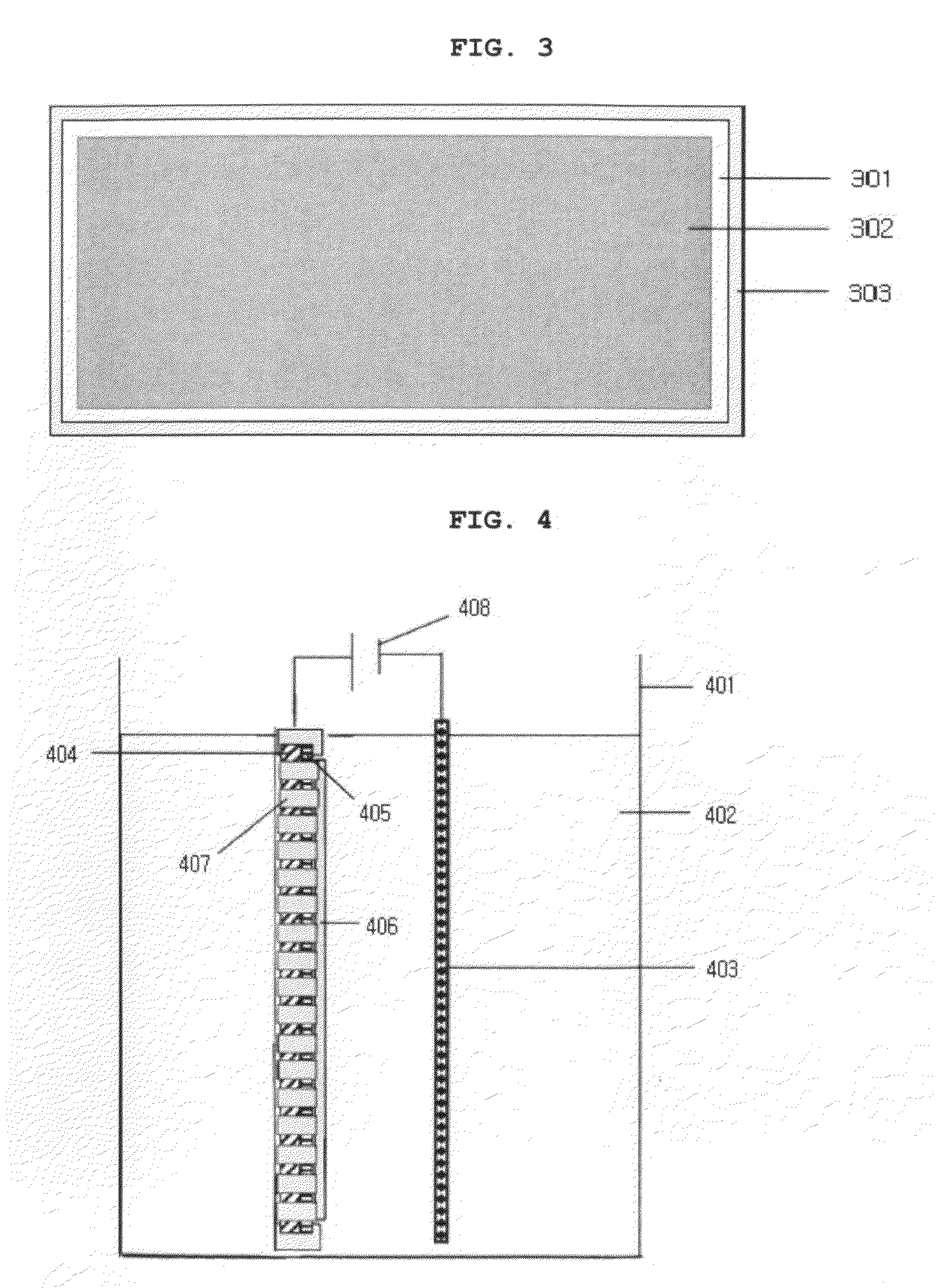[0033]Accordingly, when lithium
nickel oxide (LixNi1−yO) is forced to have a stoichiometric structure before the obtaining of an electrochromic device, lithium
nickel oxide may not include both Ni2+ and Ni3+ and nickel has only a single oxidation number. An electrochromic device including such lithium
nickel oxide can have the maximized optical and electrochromic properties through complete oxidation / reduction reactions.
[0042]In the present invention, in order to solve the above described problem in a format process of a
wide area electrode, a voltage is applied in all directions along the circumference of a transparent electrode. For example, a voltage applying means capable of contacting with the entire outer circumference of an electrode (for example, a jig surrounding the outer circumference of an electrode, like a frame) may be in contact with the outer circumference of an electrode. (see, FIG. 3) Also, a conventional voltage applying means easily contacting with an electrode and having a small contacting area (such as an
alligator clip) may be disposed on the outer circumference of an electrode with a predetermined interval, and may be in contact with an electrode. (see, FIG. 2) When oxidation / reduction voltages are applied in all directions along the circumference of an electrode in this manner, there is little difference in
electron-transfer rates between a portion to which a voltage is directly applied and other portions to which a voltage is not directly applied, contrarily to the case where a voltage is applied to only one portion of an electrode. The formatting rate of all portions may be almost the same. Therefore, since the electrode obtained through the formatting process shows a high transparency of about 80˜90% through reduction, and overall uniform transparency, it is possible to achieve excellent electrochromic properties. Such an effect according to the present invention is outstanding in a
wide area electrode having an area of about 100×100˜1000×1000 mm2, and preferably an area of 100×100˜240×360 mm2.
[0044]In a formatting process in the present invention, a voltage is applied in all directions along the outer circumference of an electrode, and / or a lithium nickel oxide electrode and a counter electrode are disposed horizontally above a ground surface in an
electrochemical cell including
electrolyte. Therefore, the formatting process is uniformly performed on the entirety of the electrode, and thus it is possible to obtain an electrode having excellent electrochromic properties.
[0049]In a formatting process, it is preferable that an oxidation voltage is within the range of 1˜3.2V, and a reduction voltage is within the range of −1˜−2.7V. The maximum of an applicable voltage varies according to the thickness of an electrode and the resistance value of a voltage applying means. In the oxidation of an electrode, when an applied voltage is 3.0V or more, the electrode may be quickly present in an
oxidation state of Ni3+. However, if the applied voltage is 3.2V or more, such an excessive voltage may cause a
decomposition reaction of an electrode. In the same manner as the above oxidation voltage, the reduction applied voltage also varies according to the thickness of an electrode and the resistance value of a voltage applying means. When the applied reduction voltage is −2.7 V or less, side reactions may occur in an electrode. In the oxidation / reduction, an applied voltage is related to the time of a formatting process. In other words, as a
high voltage is applied, the formatting process may be completed within a short time. However, since side reactions may occur in an
electrode material, the formatting process is required to be efficiently completed within a short time by applying a maximum voltage within the range where the occurrence of the
decomposition of an
electrode material and the side reactions is minimized. Accordingly, it is possible to efficiently perform the formatting process by performing oxidation / reduction reactions within the range of less than 10 times where the durability of an electrode is not influenced. After a device is obtained, an applied oxidation / reduction voltage is required to be more than a value where an electrochromic material may be color-changed, and is required to be within the range of an
electrochemical window of
electrolyte within the device. Also, the applied voltage has to have an appropriate value allowing the device to be durable through tens of thousands of repeated processes. In the case of a device operation, an
operating voltage of 1.7 V or more facilitates the
decomposition reaction of electrolyte, thereby causing bubbles. On the other hand, in the formatting process according to the present invention, oxidation / reduction reactions of lithium nickel oxide may be performed with a higher voltage than that of the device operation.
[0059]As the temperature of the electrolyte in a formatting process is increased, the
diffusion rate of lithium ions within the electrolyte is raised. Accordingly, it is possible to shorten the time for the formatting process by performing the formatting process at high temperatures (for example, at 15° C. or more) where electrochromic properties are not changed, and at temperatures lower than a
boiling point or a decomposition point of the electrolyte. In the formatting process according to the present invention, the temperature of the electrolyte may be varied according to the kind of an electrolyte
solvent, but is not particularly limited as long as the temperature is higher than 15° C. and lower than a
boiling point or a decomposition point of the electrolyte. When
propylene carbonate is used as the electrolyte, the temperature of the electrolyte for the formatting process may preferably be within the range of 15˜120° C.
 Login to View More
Login to View More 


